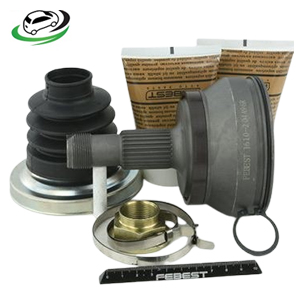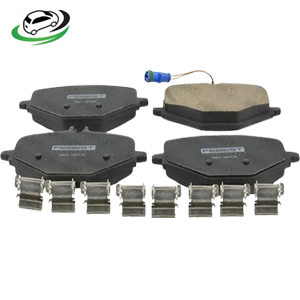-11%
Get Front Brake Pad Kit Mercedes Benz G 500 463.# 1601-167CF
A brake pad kit is an essential component of a vehicle’s braking system, playing a crucial role in ensuring effective and safe stopping power. Understanding the structure, function, types, importance, and maintenance of brake pad kits is vital for vehicle safety and performance. This comprehensive guide explores the intricacies of brake pad kits.
Structure of a Brake Pad Kit
A typical brake pad kit includes the following components:
- Brake Pads: The primary components, brake pads consist of a friction material bonded to a metal backing plate. The friction material is designed to create the necessary friction against the brake rotor to slow down or stop the vehicle.
- Shims: Shims are thin layers of material placed between the brake pad and the caliper to reduce noise, vibration, and harshness (NVH). They help dampen vibrations and prevent brake squeal.
- Hardware: Brake pad kits often include various hardware components such as clips, springs, and pins. These components ensure proper alignment and secure attachment of the brake pads within the caliper.
- Wear Sensors: Some brake pad kits include wear sensors that alert the driver when the brake pads are worn and need replacement. These sensors can be mechanical or electronic.
- Grease: High-temperature brake grease is sometimes included in the kit to lubricate the caliper pins and other moving parts, ensuring smooth operation and preventing corrosion.
Function of a Brake Pad Kit
The primary function of a brake pad kit is to ensure effective braking by creating friction against the brake rotors:
-
- Effective Braking: By generating the necessary friction and dissipating heat efficiently, the brake pad kit ensures that the vehicle can slow down or stop reliably under various driving conditions.
- Consistent Performance: High-quality materials and proper installation ensure that the braking system performs consistently, providing predictable stopping power every time the brakes are applied.
- Safety: A well-functioning brake pad kit is essential for vehicle safety. It ensures that the braking system can perform effectively, preventing accidents and ensuring the safety of the driver, passengers, and others on the road.
- Noise Reduction: The inclusion of shims and other noise-dampening elements ensures that the braking process is quiet, enhancing the overall driving experience.
- Longevity of Brake Components: Properly designed and maintained brake pad kits help to extend the lifespan of the braking system components, reducing the frequency of replacements and overall maintenance costs.
Types of Brake Pads
Brake pads are available in various types, each suited for different driving conditions and performance requirements:
- Organic Brake Pads: Made from a mixture of natural fibers, resins, and fillers, organic brake pads are known for their quiet operation and smooth braking. They are suitable for everyday driving but may wear out faster than other types.
- Semi-Metallic Brake Pads: These pads contain a mixture of metals such as steel, copper, and iron, along with friction material. They offer excellent performance and durability but can be noisier and produce more brake dust.
- Ceramic Brake Pads: Made from ceramic fibers, nonferrous filler materials, and bonding agents, ceramic brake pads provide superior performance, longevity, and minimal noise. They are ideal for high-performance and luxury vehicles.
- Low-Metallic NAO Brake Pads: These pads have a small amount of metal content and offer a balance between performance and noise reduction. They provide good stopping power and are suitable for a wide range of vehicles.signs of worn out brake pads
signs of worn out brake pads;
1. Squealing or Squeaking Noise
- Cause: Brake pads often have a built-in wear indicator, which is a small metal tab that makes contact with the brake rotor when the pads are worn down to a certain level.
- Indication: A high-pitched squealing or squeaking noise when you apply the brakes suggests that the brake pads have worn down and need to be replaced soon.
2. Grinding Noise
- Cause: When the brake pads are severely worn, the metal backing plate may come into contact with the brake rotor.
- Indication: A loud grinding noise indicates that the brake pads are completely worn out and metal-to-metal contact is occurring. This not only reduces braking efficiency but can also damage the rotors, leading to more expensive repairs.
3. Reduced Braking Performance
- Cause: Worn brake pads provide less friction, leading to diminished braking power.
- Indication: If you notice that your vehicle takes longer to stop, or you need to press the brake pedal harder to achieve the same level of braking, it is likely that your brake pads are worn out and need replacement.
4. Vibration or Pulsation
- Cause: Uneven wear on the brake pads or warped rotors can cause vibrations during braking.
- Indication: Feeling a vibration or pulsation in the brake pedal or steering wheel when applying the brakes can be a sign of worn brake pads or other issues with the braking system.
5. Thin Brake Pads
- Cause: Visual inspection can reveal the thickness of the brake pads.
- Indication: If the brake pads appear to be less than a quarter of an inch (approximately 3 millimeters) thick, they are nearing the end of their lifespan and should be replaced soon. Most pads should be replaced when the friction material is 3mm to 4mm thick.
6. Warning Light
- Cause: Some modern vehicles are equipped with electronic wear sensors.
- Indication: If your vehicle’s dashboard displays a brake warning light, it could indicate that the brake pads are worn and need inspection or replacement. Refer to your vehicle’s manual to understand the specific warning lights.
7. Pulling to One Side
- Cause: Uneven wear or a malfunctioning brake caliper can cause one brake pad to wear out faster than the other.
- Indication: If your vehicle pulls to one side when braking, it could be a sign of uneven brake pad wear or a problem with the brake caliper.
8. Brake Pedal Feels Soft or Spongy
- Cause: Worn brake pads can affect the hydraulic system in the braking mechanism.
- Indication: A soft or spongy brake pedal feel can indicate that the brake pads are worn and that air or moisture may have entered the brake lines. This requires immediate attention.
9. Burning Smell
- Cause: Overheating of the brakes due to worn-out pads.
- Indication: A strong, acrid smell after heavy braking or during normal driving can indicate that the brake pads are overheating. This can be dangerous and requires immediate inspection.
Maintenance of Brake Pad Kits
Proper maintenance of brake pad kits is crucial to ensure their longevity and optimal performance:
- Regular Inspection: Periodically inspect brake pads for wear and damage. Check for uneven wear, cracks, or glazing on the friction material.
- Timely Replacement: Replace brake pads when they reach the minimum thickness specified by the manufacturer or when wear sensors indicate the need for replacement.
- Cleaning: Keep the brake components clean from dirt, dust, and debris. Use a brake cleaner to remove contaminants that can affect braking performance.
- Lubrication: Apply high-temperature brake grease to caliper pins and other moving parts to ensure smooth operation and prevent corrosion.
- Proper Installation: Ensure that brake pads and hardware components are installed correctly. Follow the manufacturer’s instructions and use the appropriate tools for installation.
Follow us on Facebook for more parts.



